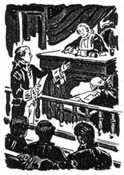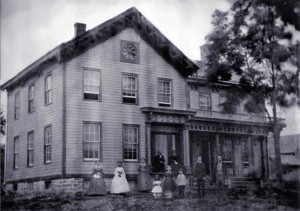









Gallery |
I came across this record last year sometime, and the exercise to determine the voyage date spurred my memory. The first tangible record of Jellis (Gillis) in America has been established as that found in Fort Orange on October 15, 1651 when he received permission from the court to distill liquor in Greenbush, a small village near Albany.  Early Albany Court However… a new record has been found in the book “Early Irish in Old Albany” which places him there a couple of months earlier. Not a big difference, but nonetheless, this appears to be the earliest tangible record of a Fonda in the New World: Early Irish in Old Albany, N.Y.: with special mention of Jan Andriessen, “De Iersman Van Dublingh”, Danaher, Franklin M., Boston, MA, American-Irish Historical Society, 1903, p. 17: […the court records show that on August 18, 1651, “Thomas Konnig abused the court as an unlawful court, taking materials from the sayings of Dyckman, who sang the 82nd Psalm and called the high council rogues and tale bearers in presence of Evert Pels, Art Jacobse and Gillis Fonda.”] Evert Pels was also listed in the October 15 court record as the party selling distillation equipment to Gillis for the production of liquor. It is odd that the men were in court merely observing two months prior to their court date. Perhaps they were preparing for their upcoming petition. Jellis had been an innkeeper and blacksmith in Amsterdam. Brandy was a product of high value in New Amsterdam. The skills and knowledge needed may have been similar. Although none of the early Fonda’s were known as anything but pious in nature, the making of spirits was a worthwhile commercial venture in the fur trading environs of early Albany.
The “Famous Frisians in America” book had a record for the burial of Abraham Fonda, youngest child of Jellis Douw, in Amsterdam on October 28, 1650. This new information has led me to revise the thinking on the voyage to America. Here is the account I just posted on the main website: Jellis Douw Fonda – Voyage to America Although we do not know upon which ship Jellis Douw Fonda and family made their voyage to America, we can make an educated guess or at least narrow it down. The following two facts serve as a window for the timing: 1. The youngest child of Jellis and Hester, Abraham, was baptized on April 14, 1647 in Amsterdam, Netherlands (“Amsterdam Records of the Fonda Family”, The New York Genealogical and Biographical Record, Vol. 119, No. 1). He was buried on October 28, 1650 according to Amsterdam burial records. (“Famous Frisians in America”, p. 108-109). 2. The first record of Jellis (Gillis) in America was in Fort Orange (now Albany, NY) on October 19, 1651 when he received permission from the court to distill liquor in Greenbush, a small village near Albany (“A Career Woman in 17th Century New York”, The New York Genealogical and Biographical Record, New York, Vol. 95, No. 5) So we know that the migration took place between November 1650 and October 1651. According to “A Career Woman in 17th Century New York”, when Jellis arrived in Fort Orange in 1651, “he was accompanied by his wife, Hester Jans, and three children, a son Douwe, aged about eleven years, and daughters Geertien and Sara, aged about nine and seven years, respectively”. No ship passenger lists have yet been found which show any names resembling Jellis/Gillis Fonda and his family. So, if you look at the ships that DO NOT have passengers lists, maybe we can narrow it down some. We know that Jellis did not enter into a contract with the Rensselaerswijck Colony (typically three to six year terms of farm labor in return for the ship’s passage). He must have been a free colonist, paying for his own ships fare, since he was not encumbered with any work contracts that we know of. According to the Marine Museum (translated from the original Dutch by Willem Rabbelier and Cor Snabel of the Netherlands, published with their permission on The Olive Tree Genealogy pages): “The book/thesis of Jaap Jacobs contains a list of about 500 ship crossings between Amsterdam, the Netherlands and New Amsterdam over the period 1609-1675. In only 56 cases the presence, but not the names, of colonists on board is mentioned.” (De Scheepvaart En Handel Van De Nederlandse Republiek Op Nieuw-Nederland 1609-1675 by J.A. Jacobs 1989) http://www.olivetreegenealogy.com/nn/mm_shipamny.shtml There were only 5 ships sailing from The Netherlands to America in 1651: 1. WATERHONT particulier Amsterdam 5 5 1651 Nieuw-A’dam 1651
Three had passenger lists which do not list any names resembling this family. The ships in this list which DID NOT have passenger lists are: 1. BONTE KOE particulier Amsterdam 1651 Nieuw-A’dam voor 13 6 1651 So unless there are more ships that we don’t know about, you can conclude that Jellis Douw Fonda, his wife Hester Jans and his three young children, Douwe, Grietje and Sara sailed on one of these two ships… the BONTE KOE or the PRINS WILLEM. These are the only ships which fit in the correct time frame, from the correct location and do not have passenger lists. * HCC=Hans Claesz. Compagnie
It is not known exactly when or why Jellis and family immigrated to America, other than the obvious desire for freedom and opportunity. There is no known record of the family on published ship passenger lists. A best guess, based on available information indicates they probably sailed on either the BONTE KOE or the PRINS WILLEM, each arriving in New Amsterdam in June-September 1651. Albany, New YorkAccording to “A Career Woman in 17th Century New York,” when Jellis arrived in Fort Orange (now Albany) in 1651, “he was accompanied by his wife, Hester Jans, and three children, a son Douwe, aged about eleven years, and daughters Geertien and Sara, aged about nine and seven years, respectively.” The Fonda Family was one of eighty-two distinct family groups representing the settler population of Albany at the end of the so-called Dutch period (1624-1686). Already, these urban dwellers were beginning to distinguish themselves from the farmers and husbandmen of the surrounding countryside. These families represented the largest number of New Netherlands family names in the city during its first two centuries of life. From this core group, a number of families left the Albany community, establishing new settlements at Schenectady, Kinderhook, Catskill, Schaghticoke, Hoosick, Saratoga, and beyond. Some became tenants of the Rensselaerwyck Patroon (cooperative). Others left the region entirely. Still others literally “died out” in the Albany setting. Those who remained formed the core population of what became the city of Albany in 1686.  Fonda Farm House, 1859 Fonda, New YorkBefore the American Revolution, a Dutch village named Fonda had succeeded the Indian hamlet of Caughnawaga, along the Mohawk River, about 30 miles west of Albany. It extended from the rambling hills which comprise the Mohawk Valley, at the foot of which stood the church and parsonage, down to the river. Douw Jellis Fonda (1700-1780), father of the branch of the Fonda family so prominent in this neighborhood from the mid-1700’s to the present, is considered the founder of this village, which now bears his name. Douw lived a long and prosperous life as a farmer and merchant. He was killed during a raid by the British Army, aided by the Mohawk Indians, on May 22, 1780; he was 79 yrs. old. His house was plundered and burned; and his sons, John and Adam, were taken as prisoners to Canada. Douw had been a close personal friend of the British constable, Sir William Johnson, and had always been on good terms with the Indians, but his life was taken as “heartlessly” as though he were an active enemy. His legacy remained through his abundant offspring, which included 6 children and 30 grandchildren. After the war Adam returned and built a house which is still standing in the village of Fonda. Older brother Jellis became a judge in Tryon County and was serving in the Legislature when he died. Adam’s son Henry who served as a captain in the War of 1812 had twin sons called Henry Douw and Douw Henry. Douw Henry, the father of Albert Fonda whose son is the present owner, built the farm home between 1842-50. Now on this farm is the ninth generation of the family in America; the seventh on these historic acres. (Century Farms of New York State – 1947). |